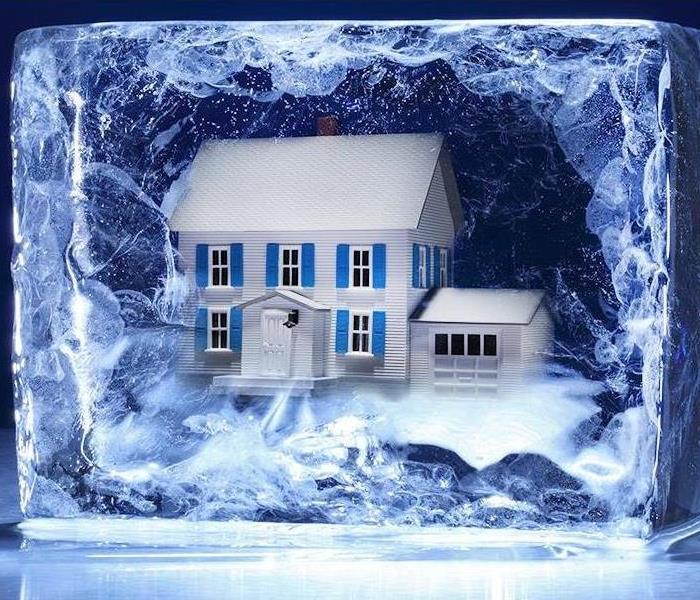Archived General Blog Posts
Spotting Previous Damage When Buying a New Home
1/5/2024 (Permalink)
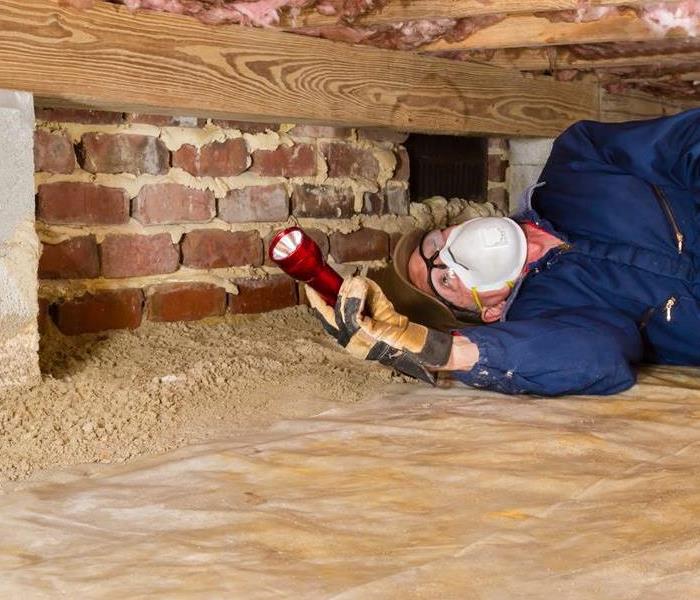 A home inspector check the crawlspace for any signs of previous damage or mold growth.
A home inspector check the crawlspace for any signs of previous damage or mold growth.
Embarking on the journey to purchase a new home is thrilling, but a cautious approach is key to a successful investment. As you tour potential properties, pay close attention to signs of previous damage, especially water or mold issues. Check for discolored patches on walls, ceilings, or floors, as they could indicate hidden problems. Engage a home inspector to thoroughly assess the property and reveal any potential issues. Delve into the property's history, examining past renovations, and disclosure reports. By navigating the home-buying process with diligence, you equip yourself to make an informed decision and secure a new home free from unwelcome surprises. If you have purchased a new home and are concerned about previous damage that could impact the integrity of your home, call your local SERVPRO.
The Importance of Attic Care
1/5/2024 (Permalink)
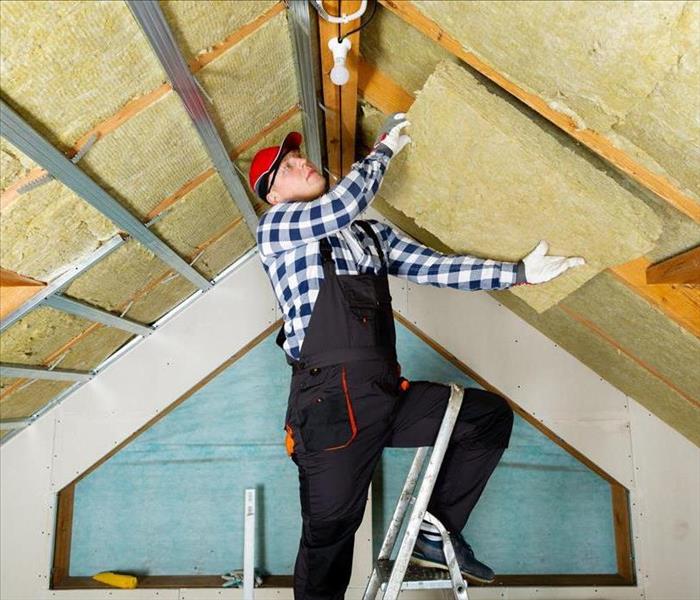 This man is installing thermal roof insulation in an attic.
This man is installing thermal roof insulation in an attic.
Often relegated to a forgotten corner of our homes, the attic is a space with untapped potential. Beyond being a storage area, this often-overlooked space plays a crucial role in maintaining the overall health of your home. Proper insulation in the attic contributes to energy efficiency, preventing heat loss in winter and minimizing heat gain in summer. Adequate ventilation is essential to control moisture and prevent the growth of mold. Regular inspections for pests, leaks, and proper insulation maintenance are key to a well-functioning attic. By investing time and attention into this space, you not only ensure a healthier living environment but also contribute to the longevity of your home. Don't underestimate the impact of an attic on your home. If you are concerned about mold growth or water damage to your attic, call your local SERVPRO® today.
Ways to keep your house cool this summer
8/18/2019 (Permalink)
In warmer months, it's tempting to crank the AC or plant yourself in front of the nearest fan. But these aren't the only tricks to keeping cool. It turns out there are plenty of ways to cool down your home from the heat without racking up your electric bill.
Keep your blinds closed. Did you know that up to 30 percent of unwanted heat comes from your windows? Better yet, invest in blackout curtains. Both will help keep the sunlight from coming in. Closing off unused rooms will prevent cool air from permeating these areas during the hottest part of the day keeping the cooler air in the places you are utilizing. Use a fan instead of turning on the A.C. Filling a mixing bowl with ice or something equally cold, like an ice pack, and position it at an angle in front of a large fan so the air whips off the ice in an extra-chilled is another great way to keep cool air flowing throughout your home. Also be sure to set your ceiling fans to rotate counter-clockwise. You may not realize that your ceiling fan needs to be adjusted seasonally. Setting your fans to run counter-clockwise in the summer at a higher speed, the airflow will create a wind-chill breeze effect that will make you feel cooler. Turn on your bathroom fans or the exhaust fan in your kitchen too.
Ditch the incandescent lights.Incandescent bulbs waste about 90 percent of their energy in the heat they emit. It will make a small difference in cooling your home while also lowering your electric bill. Using your oven or stove in the summer will definitely make your house hotter. If it already feels like 100 degrees in your home, the last thing you want to do is turn on a 400-degree oven.Grill out your meals instead. This really is the best season for it!
And don’t forget to focus on the temperature in your body, not the house.Cool drinks and applying a cold cloth to strong-pulsed areas, like your neck and wrists, will keep you cool from the inside out.
Here at SERVPRO of North Cabarrus County & China Grove, we want to make sure that your home is running efficiently. And should you need any of our 24 hour, seven day a week services, don’t hesitate to give us a call. We’re always “Here To Help!”
3 Minutes on Fire Extinguishers
6/29/2018 (Permalink)
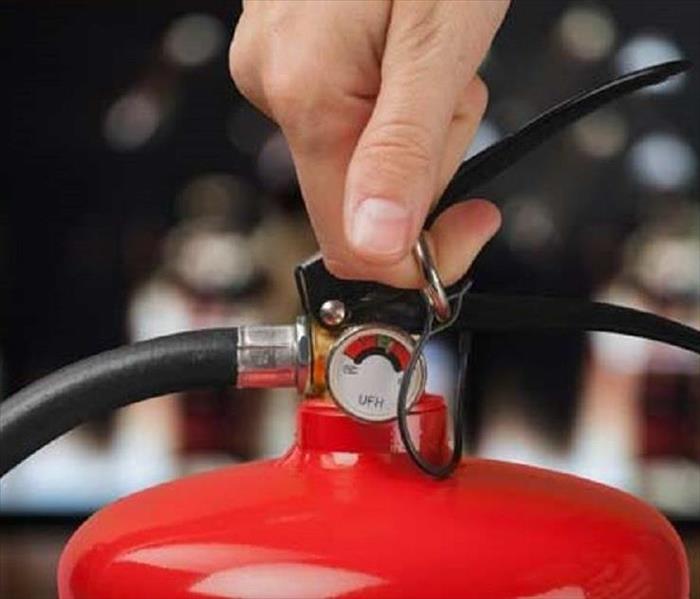 What Size Kitchen Fire Extinguisher Do You Need?
What Size Kitchen Fire Extinguisher Do You Need?
f you find yourself dealing with a fire in your kitchen in the future, you’ll be glad you took the 3 minutes to read this post and learn the best fire extinguisher for kitchen fires.
We’re taking the time to write this blog because all fire extinguishes aren’t created equally – and neither are the fires they put out. It’s important to know the different types of fire extinguishers, how they’re used, and some of the best types of fire extinguishers for kitchen are so you’re prepared in case of an emergency.
Keep in mind this information is provided to help you deal with small grease fires in the kitchen, preferably while someone else is calling the fire department to your home.
Different Classifications of Fire Extinguishers
Household fire extinguishers have different classifications that tell you what type of fire they are capable of putting out. If you use the wrong class on a fire, you could make the situation worse. Luckily, fire extinguishers are clearly labeled.
Class A: For trash, wood, and/or paper fires.
Class B: For liquids and/or grease fires.
Class C: For electrical fires.
Class D: For flammable metals (usually only needed in labs or industrial plants).
Class K: Specifically for kitchen fires when grease and oil are involved.
Note, some fire extinguishers may be rated in more than one class which means you can use them on different types of fires.
What Size Kitchen Fire Extinguisher Do You Need?
There are several sizes of extinguishers to choose from. How do you know what size makes the best fire extinguisher for kitchen use? It’s a pretty easy choice once you know the recommendations based on the sizes.
Classes A and B also have a number before the letter that tell you basically how much fire it can handle.
For Class A extinguishers, the number (from 1 to 40) represents the equivalency for gallons of water. 1 is equal to 1.25 gallons of water, so a 3 rated extinguisher is the same as 3.75 gallons of water.
For Class B extinguishers, the rating goes from 1 to 640 and it represents square footage a fire can handle. 20B means you’ll be able to handle a fire that’s spread to cover 20 square feet.
For Class C, D, and K, there are no numbers, so you’ll use the numbers from the A and B ratings to choose your extinguisher.
Keep in mind that the extinguisher size also varies based on the weight. Typically, there are 4 lbs, 5 lbs, 10 lbs, and 20 lbs extinguishers. Bigger isn’t always better here – if you can’t pick up the extinguisher and sweep it to put out the fire because the device is too heavy, you’ll wish you chose the 5 or 10 pounder instead of the 20. Note: extinguishers are heavier than their displayed weight when fully charged.
PASS: How to Use a Fire Extinguisher
Knowing what fire extinguisher to use based on the type of fire you’re dealing with is only half the battle. You also need to know how to use a fire extinguisher. A good way to remember what to do in a moment of panic is the acronym P.A.S.S. It stands for:
Step 1: Pull the pin.
Step 2: Aim the extinguisher at the kitchen fire low with the nozzle at the base of the fire.
Step 3: Squeeze the handle to begin extinguishing the fire.
Step 4: Sweep the extinguisher side to side at the fire’s base until it’s out. Be careful of re-ignition.
5 of the Best Fire Extinguishers for Kitchens
Some of our favorite fire extinguishers for kitchen fires are:
- Amerex B500 Rechargeable 5-lb Extinguisher: Weighs under 10 pounds fully charged and works with all three classes of home fires.
- WilliamsRDM Stovetop Firestop Extinguisher: This kitchen fire extinguisher is mounted above your stove and activates when it detects fires. It uses baking soda and installs flawlessly via a magnet. You’ll need to purchase another extinguisher to have on hand for other types of fires that happen away from the stovetop.
- Kidde 466112 Pro Dry Chemical Fire Extinguisher: This extinguishers discharges in fifteen seconds or less and has a range up to fifteen feet. It’s suitable for Class A, B, and C fires, is very durable, and weighs under 10 pounds. Note: Kidde recalled extinguishers with plastic handles, but this one wasn’t part of the recall.
- First Alert Rechargeable Standard Home Fire Extinguisher: All metal and suitable for A, B, and C class fires and rechargeable (by a professional) if you have to use it.
- First Alert Fire Extinguishing Spray: One-time use, lightweight, and biodegradable, this fire extinguisher discharges for 32 seconds in a fine mist that’s easy to clean. You’ll want to keep a standard extinguisher on hand because this one is small and only single-use.
We hope you found this post about the best type of fire extinguisher for kitchen fires useful and are ordering your fire extinguishers to go in multiple rooms in your home if you don’t already have them. Remember, SERVPRO of North Cabarrus County and China Grove is here for all of your flood, fire, and mold cleanup and reconstruction. Contact us today.
704-939-1944
National Safety Month
6/28/2018 (Permalink)
 SERVPRO of North Cabarrus County & China Grove, one of our five core values is Safety Obsession
SERVPRO of North Cabarrus County & China Grove, one of our five core values is Safety Obsession
I don’t know about you, but I completely obsess when I’m trying to make a big change, achieve a personal goal, adopt a new behavior or switch to a new way of thinking. Whether it’s getting in 10,000 daily steps, eating more fruits and vegetables or drinking eight glasses of water every day – it takes unwavering focus and effort to change our actions, and even more continuous effort to change our mindsets and convert our behaviors long-term.
At SERVPRO of North Cabarrus County & China Grove, one of our five core values is Safety Obsession – an unwavering focus on safety designed to change not just our behavior but our mindset about what it means to be safe.
But safety at work is only half of the equation. The other half is what happens outside of work. Why? Because we want all employees to return safely to their families, homes and communities at the end of each work day. We need to think about safety not just through the lens of work; we need to think about safety from all angles and all sides.
I look forward to exploring in future blogs the practices, behaviors and commitments required to build a Safety mindset. For now, I hope you will join me, not just for National Safety Month, but every day, in making your own safety and the safety of others a priority — no, an obsession.
For immediate service SERVPRO of North Cabarrus County & China Grove.
5/30/2018 (Permalink)
SERVPRO of North Cabarrus County & China Grove provides 24-hour emergency service and is dedicated to being faster to any-sized disaster in Rowan County. We can respond immediately to your emergency and have the expertise to handle your restoration or cleaning needs.
- 24-Hour Emergency Service
- Faster to Any-Sized Disaster
- Highly Trained Restoration Technicians
- A Trusted Leader in the Restoration Industry
- Locally Owned and Operated
- Advanced Restoration and Cleaning Equipment
Have Questions? Call Us 24/7 704-939-1944
Residential Services
Whether your North Cabarrus County or China Grove home needs emergency flood damage or your upholstery cleaned, you can depend on us. Our technicians have extensive cleaning and restoration training and can make your property look its best. Learn more about our residential services:
- Water Damage Restoration
- Fire Damage Restoration
- Mold Remediation
- Storm Damage Restoration
- Cleaning Services
- Building/Reconstruction Services
Commercial Services
There's never a convenient time for fire or Water damage to strike your commercial property. Every hour spent cleaning up is an hour of lost revenue and productivity. So when the need arises for professional cleaning or emergency restoration services we have the training and expertise to respond promptly with highly trained technicians to get your property back to business. Learn more about our commercial services.
- Commercial Water Damage Restoration
- Commercial Fire Damage Restoration
Dos and Don'ts of Heat Safety
6/21/2016 (Permalink)
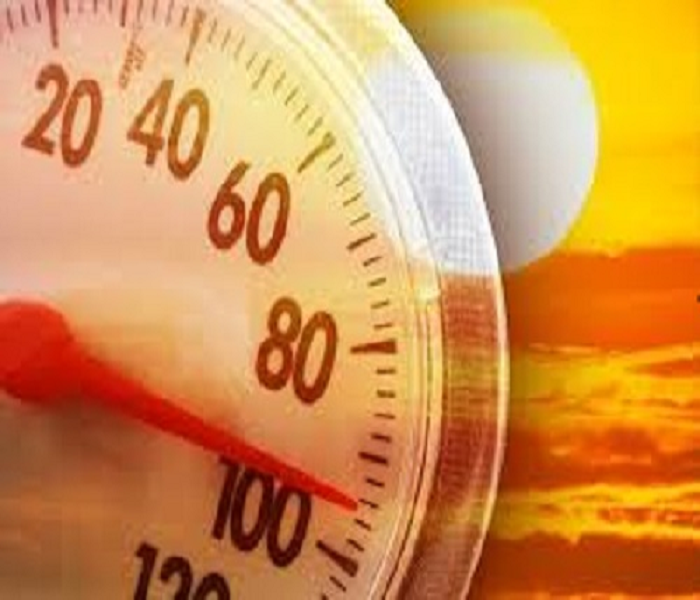 Summer Heat Safety Tips
Summer Heat Safety Tips
According to data from the National Weather Service, hot temperatures harm more people—and take more lives—each year than floods, lightning, tornadoes, and hurricanes combined.
For starters, Drink when you're thirsty! Thirst kicks in when you're already around 2 percent dehydrated. On most days, women need about 9 cups of fluids, while men require 13 cups.
DO Wear lightweight, light-colored, loose-fitting clothing.
DO Limit your outdoor activity to morning and evening hours.
DO have small, frequent meals.
DO Protect yourself from the sun by wearing a wide-brimmed hat (also keeps you cooler) and sunglasses and by putting on sunscreen of SPF 15 or higher.
DON'T drink too much alcohol.
DON'T rely solely on Electric fans.
DON'T leave the children or pets in the car
DON'T work outside alone - use the buddy system.
DO Check on family, friends and neighbors who do not have air conditioning, who spend much of their time alone or who are more likely to be affected by the heat.





 24/7 Emergency Service
24/7 Emergency Service


